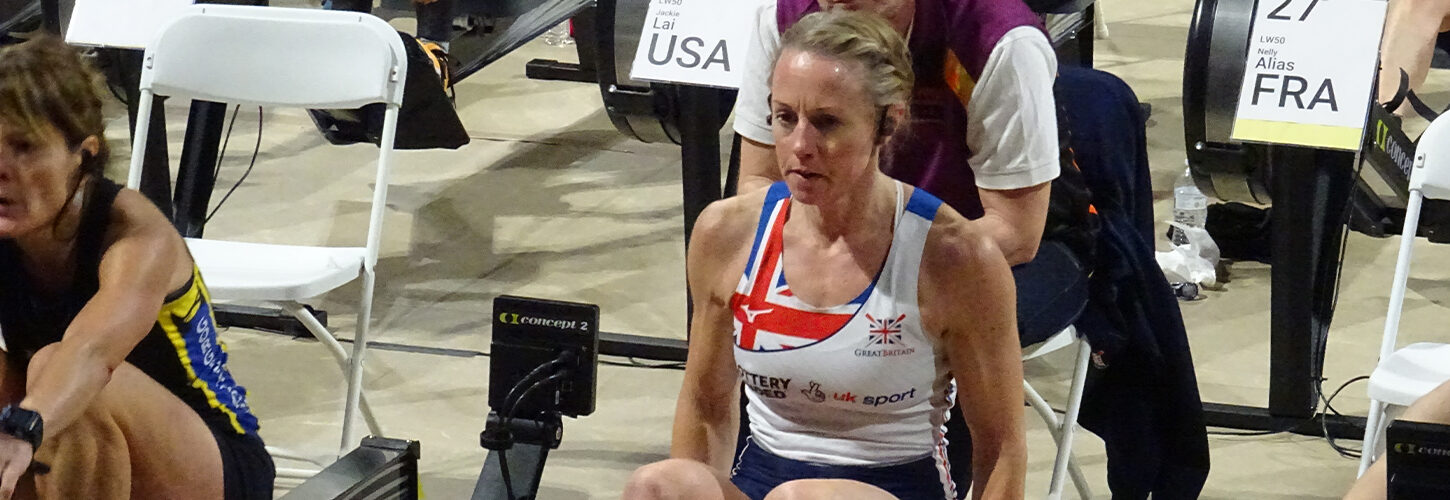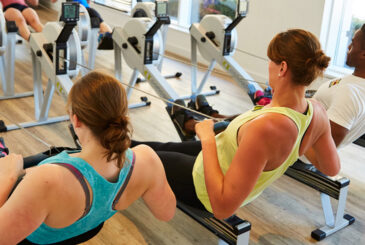With BRIC Online getting ever closer, three-time British and four-time World Indoor Rowing Champion Justine Reston goes over some key preparation tips for indoor racing to help you feel, row and perform at your best, even at home.
4-6 Weeks before the event: strive for your best and push your limits
A good time to gear up your preparation for an indoor rowing competition is around 4-6 weeks before race day. After months of building my aerobic base, I am well into specific race preparation mode by now. You should be following a specific training plan for the race distance you have entered (download British Rowing’s BRIC Online plan here) and hopefully getting invaluable support from friendly fellow rowers or a coaching group. For new indoor rowers in particular, I recommend testing yourself early in training over race distance. This helps set a target pace for your training and a goal time for the race. For me, having a pace focus is vital. It informs the aim of all my speed sessions and is likely to lead to a successful race target pace and Personal Best (PB).
During this period, you want to schedule time to taper your training so you are rested and raring to go on race day. Counting back from the event date to include tapering is a really good way to do this.
Your training at this stage should include sessions that push your ability and become consistent at your planned race pace. These sessions, for more experienced indoor rowers, are an opportunity to practice a new goal race pace if you are gunning for a PB. I use classic 2K intensity speed interval sessions such as 4x750m [3 minutes rest], 8×500 [1:30 minutes rest] and 3 or 4x1000m [5 minutes rest] all done at a high stroke rate. They are tough sessions which, amongst other physiological adaptations, train you to tolerate pain. If these sessions are rowed with consistency and discipline, they can become a realistic indicator of a pace close to 2k pace. These sessions really boost my confidence as they provide the opportunity to imagine how it might feel to row at the event itself. If you are targeting a PB, these sessions are the perfect time to really push and see what you are able to achieve.
At this stage, I also always make a point of warming up thoroughly before speed interval sessions. A warm up is essential to prime your energy systems to perform at an optimal level – both physiologically and mentally – for the hard work to come. I use warming up as an aid to get the best out of myself. I use the same warm up on race day as it not only puts me where I need to be physiologically, but it is also familiar and comforting. Formulating a warm up around this time will give you scope to find out what works for you and lock it into your race preparation habits.
During the final two weeks of your plan, training should come to a peak of intensity and volume before heading into taper week. This is when I am most disciplined and consistent so I can look back with confidence at my preparation. If a session feels rubbish or does not quite go to plan, I complete it and move onto the next day. The mantra of my team is ‘trust the process’.
1 Week before the event: rest, recovery and plan
Following this trust, push and strive period, I use the week before the event to recover and unwind from intense training. However, I also make sure that I keep moving despite the reduction in training volume! I do some relaxed short rows as well as integrating in a mid-week short sharp session. A session I frequently use is 2/3 x 500m at 2 or 3 seconds/500m faster than your planned race pace. Practice your race warm up during this week up so it is automatic and familiar on race day.
Familiarisation with the race screen on the performance monitor (PM) is also valuable during this time. Again, practicing eliminates the unknown, allowing more space on race day to remain calm and focused. Practice setting your drag factor using this screen. Practice short bursts using the PM race start function; this is so important if it is your first indoor event as you will see the 3 part process of a race start and the commands of: “SIT READY”, “ATTENTION”, “ROW”.
These physical preparations are important but not the only things useful during taper time. I often spend some quiet time thinking about the event itself and mentally preparing my race plan. Look back over your training with a cup of tea to give yourself confidence in setting a goal pace or time you aim to complete the 2k race distance. Think about your equipment (for virtual racing) and the clothing you going to wear for the race. For virtual racing, test your internet speed against the requirements of the racing software and ensure you’ve the required PM firmware to take part. Race organisers will provide all the relevant instructions well before the event so you have time to find cables and also perform any updates to the operating system on your laptop or device.
Also during this week, I focus on my nutrition and hydration. I am incredibly strict with my diet the week before a race and only eat what I am used to rather than introduce new foods. I eat clean with healthy balanced meals and alter portion size to manage weight. If racing lightweight, keep a watchful eye on your weight throughout this week, weigh yourself each day at the time you’ll be required to weigh in on race day. Keeping well hydrated and reducing salty foods is a way to ensure you do not hold onto excess water weight. Also, you can’t beat sleep for recovery so I try to catch as much sleep as I can.
Race Day
Time to bring all your preparation together to race your best!
As a lightweight competitor, after getting out of bed on race day I go straight to weigh myself holding any fluid and food I plan to consume before weigh in!
This isn’t as important for virtual races like BRIC Online, but when competing in a new environment be sure to arrive in plenty of time to find your way around the venue and work out how to access the race area and locate the toilets. As a lightweight athlete, I am always keen to get officially weighed as soon as possible before eating, hydrating and finding a quiet place away from people to relax. Accept that you are likely be nervous rather than finding a way not to be. Do what you need to do to mentally prepare.
My race tactic is the same every time: stick to the plan! I do my best not to waiver from it. My advice is to be incredibly cautious of starting too hard and not settling into your intended race plan. It is SO easy to become carried away with the racing atmosphere and the desire to get ahead of other competitors. The anaerobic system will provide well for a limited number of strokes before the physiological effects become irreversibly negative; i.e. you fly and die. The best advice I can give for anyone is settle into race pace +1/2 seconds no later than 1800m and stay there, whatever is going on around you. Settling into your plan will enable your mind to steady and will make it easier to not worry about what anyone else is doing (this will be easier at home of course). If it helps, break the distance into sections; I often count down. With 750-500m to go, use whatever energy and determination remaining to steadily push up the pace, empty the tanks and race to the line.
It is useful to be aware that in the early stages of a race, your average pace on the PM is not a true reflection of your actual pace compared to completing a solo time trial. The race software starts the clock rather than your first pull, which results in a marginal delay in the average calculation. So my tip is don’t chase your average, focus on your actual pace.
Whether you are at a venue or virtually racing, if the race system fails, carry on. Information on your row can still be retrieved so don’t resort to stopping after all the hard work.
Racing can bring out great performances as our innate competitive nature as humans gets pushed to its limits when you are shoulder to shoulder with another athlete. Virtual racing is great at recreating this experience at home. It’s a very different experience but it is still wonderful to be able to race against people from across the country, and the globe, in the comfort of your own home!










